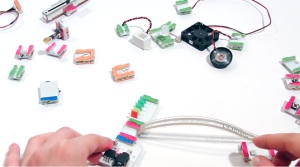 For those looking to tinker with electronics, add buzzers, lights or sensors to an object, or teach kids (or themselves) the basics of circuitry, programming, and micro-controllers, it's not as hard as you might think.
For those looking to tinker with electronics, add buzzers, lights or sensors to an object, or teach kids (or themselves) the basics of circuitry, programming, and micro-controllers, it's not as hard as you might think.
There are a number of kits available that make such projects relatively easy and accessible. Arduino, for example, offers a fairly simple hardware and software platform for people to get started.
But even with the simplicity of Arduino, there's still a rather huge barrier to entry when it comes to working with hardware and software at this level -- particularly for those with no engineering
background. Despite the openness of platforms like Arduino, the idea of wiring, soldering, and programming can be overwhelming.
As the electronics we use in our daily lives get more complicated, this turning away -- in frustration, ignorance, or fear -- is increasingly troublesome. We rely more on the very devices that are becoming like "black boxes": impenetrable. We don't understand what goes on "under the hood" of many of the objects that are most important to our lives (our cars, our smartphones).

